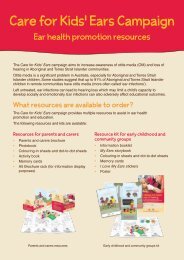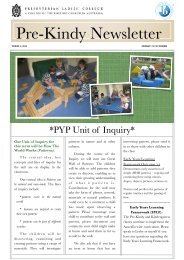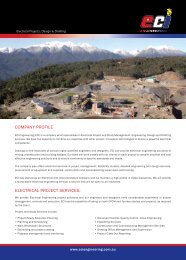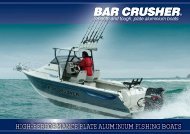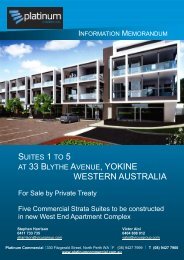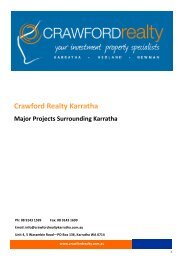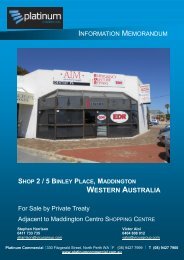Port Hedland Australia's iron ore boom town - Aussiehome
Port Hedland Australia's iron ore boom town - Aussiehome
Port Hedland Australia's iron ore boom town - Aussiehome
You also want an ePaper? Increase the reach of your titles
YUMPU automatically turns print PDFs into web optimized ePapers that Google loves.
Hot spot | port hedland<br />
<strong>Port</strong> <strong>Hedland</strong><br />
Australia’s <strong>iron</strong><br />
<strong>ore</strong> <strong>boom</strong> <strong>town</strong><br />
On the back of the commodities <strong>boom</strong>,<br />
<strong>Port</strong> <strong>Hedland</strong> offers investors not only<br />
Australia’s highest rental yields at 10% but<br />
also the promise of continued capital growth<br />
flowing from $37bn in <strong>iron</strong> <strong>ore</strong> projects.<br />
Flynn De Freitas investigates what has driven prices up<br />
$630,000 in five years and why it is still not too late for<br />
investors to buy<br />
Australia’s leading ‘superinfrastructure’<br />
<strong>town</strong> is beyond<br />
a doubt <strong>Port</strong> <strong>Hedland</strong>, a <strong>town</strong><br />
that benefited from over $12bn in <strong>iron</strong><br />
<strong>ore</strong> projects and a 45% increase in its<br />
population since 2002. To say the <strong>town</strong><br />
is ‘full’ is an understatement. Vacancies<br />
are zero and rental yields 10%.<br />
With a roaring Chinese economy,<br />
$9.5bn in new projects already<br />
approved and another $37bn proposed,<br />
and $562m in civic projects to<br />
improve local amenities for the 19,000<br />
citizens of <strong>Port</strong> <strong>Hedland</strong> and its (m<strong>ore</strong><br />
affordable) twin, South <strong>Hedland</strong>,<br />
investors have good reason to take<br />
a closer look.<br />
Despite the economic turmoil<br />
of Western economies, the<br />
urbanisation of China, India and<br />
other emerging Asian economies<br />
continues to relentlessly demand<br />
<strong>iron</strong> <strong>ore</strong> and other commodities.<br />
Indeed, Australian <strong>iron</strong> <strong>ore</strong><br />
exports surged 21% in 2009 to<br />
391 megatonnes according to the<br />
Australian Bureau of Agriculture<br />
and Resources. Further, <strong>iron</strong> <strong>ore</strong><br />
exports are f<strong>ore</strong>cast to rise another<br />
40% to 546 megatonnes by 2015 –<br />
m<strong>ore</strong> than double 2005 export levels<br />
(see Chart 1).<br />
<strong>Port</strong> <strong>Hedland</strong> is at the f<strong>ore</strong>front<br />
of Australia’s mining <strong>boom</strong>, with its<br />
population growing from 13,000 in<br />
2001 to some 19,000 today as billions of<br />
dollars worth of <strong>iron</strong> from the Pilbara<br />
region is shipped out of its port.<br />
With its population f<strong>ore</strong>cast by the<br />
local government authority (see Chart<br />
2) to surge to 27,000 by 2015 (40,000<br />
by 2025) and no easy solution to <strong>Port</strong><br />
<strong>Hedland</strong>’s chronic land shortage, the<br />
<strong>town</strong>’s property market is likely to<br />
continue soaring for years to come.<br />
The China factor<br />
M<strong>ore</strong> than any other nation in the world,<br />
China and its population of 1.2 billion<br />
people (eager to experience ‘Western life’)<br />
are driving our commodities <strong>boom</strong>. The<br />
mass migration of China’s population<br />
from farmlands to new and expanding<br />
cities is expected to see 37 cities the size<br />
of Perth emerge in the next 10 years.<br />
Amazingly in the next 15 years,<br />
nearly 255 million people (ie, 17 million<br />
18 www.yipmag.com.au
Hot spot | port hedland<br />
Chart 1: Australian <strong>ore</strong> exports<br />
600 60<br />
Volume (left axis), megatonnes Value (right axis), $bn<br />
500<br />
50<br />
400<br />
40<br />
300<br />
200<br />
30<br />
20<br />
100<br />
10<br />
0<br />
2000<br />
- 01<br />
2002<br />
- 03<br />
2004<br />
- 05<br />
2006<br />
- 07<br />
2008<br />
- 09<br />
2010<br />
- 11f<br />
2012<br />
- 13z<br />
2014<br />
- 15z<br />
Source: Australian Bureau of Agriculture and Resources<br />
Chart 2: <strong>Port</strong> <strong>Hedland</strong> population, 1996–2025<br />
40,000<br />
35,000<br />
30,000<br />
ABS data<br />
Town of <strong>Port</strong> <strong>Hedland</strong> data<br />
105% growth<br />
25,000<br />
20,000<br />
48% growth<br />
15,000<br />
each year) will relocate from rural<br />
areas into urban regions (according to<br />
research from the global consultancy,<br />
McKinsey & Company) – the equivalent<br />
of the entire adult population of<br />
Australia each year.<br />
The essential building block of the<br />
cities that will house these people is,<br />
of course, steel, which provides the<br />
framework for apartments, office<br />
towers, ports and strengthening rods<br />
of all concrete structures.<br />
China has also brushed off the<br />
economic woes of 2008 and 2009 due<br />
to its unique status as the world’s largest<br />
holder of f<strong>ore</strong>ign exchange reserves<br />
(ie, US dollar holdings) – US$2.44trn in<br />
March 2010, according to China’s central<br />
bank, the People’s Bank of China.<br />
This has meant that China could<br />
‘pay cash’ to counter the effects of the<br />
financial crisis in 2009 through the<br />
largest economic stimulus package in<br />
history – a very cool A$635bn.<br />
In doing so, China has vastly increased<br />
the number of its infrastructure (eg,<br />
roads and railways) and urbanisation<br />
10,000<br />
5,000<br />
0<br />
1996<br />
2001 2006 2010 2015 2025<br />
Source: Australian Bureau of Statistics, Town of <strong>Port</strong> <strong>Hedland</strong> Authority<br />
Chart 3: <strong>Port</strong> <strong>Hedland</strong> median value & annual growth<br />
Thousands<br />
$1,200<br />
$1,000<br />
$800<br />
$600<br />
$400<br />
$200<br />
0<br />
1991<br />
Median value<br />
1992<br />
1993<br />
1994<br />
1995<br />
1996<br />
1997<br />
Source: Residex (data to year ending June 2010)<br />
Annual growth<br />
Commodities<br />
<strong>boom</strong> begins<br />
1998<br />
1999<br />
18% 10-year annual<br />
growth average<br />
2000<br />
2001<br />
2002<br />
2003<br />
2004<br />
2005<br />
2006<br />
2007<br />
2008<br />
2009<br />
2010<br />
%<br />
40<br />
35<br />
30<br />
25<br />
20<br />
15<br />
10<br />
5<br />
0<br />
www.yipmag.com.au<br />
19
Hot spot | port hedland<br />
Chart 4: 10-year average annual house price growth<br />
20.0%<br />
18.0%<br />
16.0%<br />
14.0%<br />
12.0%<br />
10.0%<br />
8.0%<br />
6.0%<br />
4.0%<br />
2.0%<br />
18.0%<br />
0.0%<br />
<strong>Port</strong><br />
<strong>Hedland</strong><br />
Source: RP Data, Residex<br />
Chart 5: Gross rental yields<br />
10.0%<br />
9.0%<br />
8.0%<br />
7.0%<br />
6.0%<br />
5.0%<br />
4.0%<br />
3.0%<br />
2.0%<br />
1.0%<br />
0.0%<br />
10.0%<br />
<strong>Port</strong><br />
<strong>Hedland</strong><br />
Source: RP Data (as at June 2010)<br />
12.2%<br />
11.3%<br />
(eg, apartment complexes and schools)<br />
projects underway.<br />
With ANZ f<strong>ore</strong>casting China’s<br />
growth to continue to remain at<br />
approximately 9% for the next 10 years,<br />
the future demand for Australian <strong>iron</strong><br />
<strong>ore</strong> and other commodities is assured.<br />
The <strong>Port</strong> <strong>Hedland</strong> <strong>boom</strong><br />
The property market of <strong>Port</strong> <strong>Hedland</strong> –<br />
comprised of the twin regions<br />
South <strong>Hedland</strong> (inland) and <strong>Port</strong><br />
<strong>Hedland</strong> (coast) – has undergone an<br />
amazing <strong>boom</strong>.<br />
The <strong>town</strong> has long experienced<br />
sustained and strong capital growth<br />
(see Chart 3), with median house<br />
values rising from $66,000 to $184,000<br />
over the 10 years to 2000. Over the<br />
following five years, values doubled to<br />
$361,000. The current average price for<br />
9.9%<br />
9.5%<br />
6.6%<br />
Perth Brisbane National Melbourne Sydney<br />
3.9%<br />
Perth –<br />
houses<br />
4.2% 4.0%<br />
Perth –<br />
units<br />
National –<br />
houses<br />
4.8%<br />
National –<br />
units<br />
<strong>Port</strong> <strong>Hedland</strong> and South <strong>Hedland</strong> sits<br />
at $740,000.<br />
While the median house prices<br />
have grown nationally at a 10-<br />
year average annual growth rate of<br />
9.9% (12.2% and 11.3% for the<br />
commodities <strong>boom</strong> capitals of Perth<br />
and Brisbane respectively), this pales<br />
in comparison to returns investors<br />
have made by directly investing in<br />
<strong>Port</strong> <strong>Hedland</strong>.<br />
Specifically, median house values for<br />
<strong>Port</strong> <strong>Hedland</strong> have risen at double the<br />
national 10-year average annual growth<br />
rate – a stellar 18%.<br />
The reasons for this phenomenal<br />
<strong>boom</strong> in prices come down to the influx<br />
of thousands of very well-paid miners<br />
and the <strong>town</strong>’s severe land supply<br />
constraints, which have seen years of<br />
zero or near zero vacancy levels.<br />
Rental yields are a staggering 10%<br />
– easily the highest in Australia (see<br />
Chart 5) – and have been at these levels<br />
for many, many years as the <strong>town</strong> has<br />
struggled to cope with the influx of<br />
workers associated with the numerous<br />
<strong>iron</strong> <strong>ore</strong> projects in the Pilbara region.<br />
Consequently, at the start of the<br />
commodities <strong>boom</strong>, astute investors<br />
seeking the likely huge demand for <strong>iron</strong><br />
<strong>ore</strong> by China snapped up four-bedroom<br />
homes in <strong>town</strong> for between $210,000<br />
and $240,000 in 2002 and 2003.<br />
Seven years later, these homes now<br />
fetch between $950,000 and $1.2m, with<br />
rents of $1,200 per week for a $600,000<br />
property in South <strong>Hedland</strong> and $2,000<br />
per week for $950,000 homes in <strong>Port</strong><br />
<strong>Hedland</strong>.<br />
Mines and land supply constraints<br />
<strong>Port</strong> <strong>Hedland</strong> had been a remote outpost<br />
on Australia’s north-west coast, 1,700km<br />
from Perth. This has all changed in the<br />
last 10 years.<br />
The expansion and opening of over<br />
20 mines in the Pilbara region have<br />
dramatically altered the <strong>town</strong>’s property<br />
market, which is essentially land-locked<br />
by expansive flood plains.<br />
The sudden transformation of<br />
<strong>Port</strong> <strong>Hedland</strong> into Australia’s largest<br />
exporting port by tonnage, and resultant<br />
large wage increases combined with the<br />
<strong>town</strong>’s unique land supply constraints,<br />
have made a perfect recipe for its<br />
property <strong>boom</strong>.<br />
Further, the dramatic rise in ‘fly in/<br />
fly out’ (FIFO) workers from Perth<br />
and interstate into <strong>Port</strong> <strong>Hedland</strong> means<br />
FIFO workers now account for some<br />
2,000 (11%) of the <strong>town</strong>’s population.<br />
As Australia enters the second leg of<br />
the commodities <strong>boom</strong>, these powerful<br />
forces will continue to exert strong<br />
upwards pressure on <strong>Port</strong> <strong>Hedland</strong>’s<br />
rents and property prices.<br />
Miners and their $100,000 salaries<br />
The mining <strong>boom</strong> has rapidly boosted<br />
the <strong>town</strong>’s average salary for workers,<br />
which has risen 39% within seven years<br />
from $43,000 to $60,000 in 2007 – the<br />
latest data available from the Australian<br />
Bureau of Statistics – and has most likely<br />
continued to rise over the last two years.<br />
This rapid rise is due to the fact that<br />
virtually every worker employed by<br />
BHP Billiton and Fortescue Metals<br />
Group (which export <strong>iron</strong> <strong>ore</strong> out of<br />
20 www.yipmag.com.au
Hot spot | port hedland<br />
<strong>Port</strong> <strong>Hedland</strong>), the numerous mining<br />
contractors and extensive port facilities<br />
are on $100,000-plus salaries.<br />
These large salaries are a result of<br />
the flood of wealth mining companies<br />
and their suppliers have enjoyed from<br />
<strong>boom</strong>ing <strong>iron</strong> <strong>ore</strong> prices, the <strong>town</strong>’s<br />
remote and hot location (its annual<br />
median temperature is a scorching<br />
33°C) and the fact there is a chronic<br />
shortage of workers in Western<br />
Australia’s remote ‘resources’ sector.<br />
Despite the global slow-down of<br />
2008/09, this acute shortage of mining<br />
workers continues unabated. Indeed, the<br />
shortage of miners hit its peak in May<br />
2010 according to the ABS, with over<br />
6,200 vacant positions across Australia.<br />
Commenting on these statistics,<br />
leading labour hire firm Drake Australia<br />
said: “The mining shortage never went<br />
away. Mining workers are very hard to<br />
find. You need critical skills – m<strong>ore</strong> than<br />
other industries – and you often need<br />
them in remote locations.”<br />
Another mining recruiter, NES<br />
Global, believes because of this shortage,<br />
“wages are expected to rise 20% over<br />
Median house values for <strong>Port</strong> <strong>Hedland</strong><br />
have risen at double the national 10-year<br />
average annual growth rate – a stellar 18%<br />
the next 24 months”.<br />
The net result of this has not only<br />
been <strong>boom</strong>ing property prices but a<br />
consistent gross rental yield of 10%<br />
for investors in <strong>Port</strong> <strong>Hedland</strong> and (the<br />
m<strong>ore</strong> affordable) South <strong>Hedland</strong>. This<br />
has been one of the main draw cards for<br />
investors, given gross rental yields are<br />
m<strong>ore</strong> than double the national average.<br />
Flood plain limits land supply<br />
The first thing most investors say when<br />
they hear about the prices of houses in<br />
<strong>Port</strong> <strong>Hedland</strong> is, “why don’t they just<br />
build m<strong>ore</strong> homes” If only life was<br />
that simple!<br />
The ‘available land’ for residential<br />
construction around <strong>Port</strong> <strong>Hedland</strong> is<br />
very limited due to the vast flood plains<br />
and salt deposits that cover some 85% of<br />
the immediate area around the <strong>town</strong>.<br />
Indeed, <strong>Port</strong> <strong>Hedland</strong> could easily<br />
be 10 times its current size but for the<br />
flood plains alone. While many parts of<br />
these flood plains are dry all year round,<br />
planning restrictions on residential<br />
www.yipmag.com.au<br />
21
Hot spot | port hedland<br />
building prohibits construction in areas<br />
that may be subject to flooding on a<br />
10 years-plus basis.<br />
This safety limitation on residential<br />
land will not change, meaning that<br />
the only real way to increase housing<br />
supply in <strong>town</strong> is to increase the<br />
density of housing. Consequently,<br />
it is likely that housing pressures will<br />
not substantially abate for some time –<br />
if ever.<br />
Dramatic fly in/fly out increase<br />
An additional element to the housing<br />
<strong>boom</strong> in <strong>Port</strong> <strong>Hedland</strong> has been the<br />
dramatic increase in the number of<br />
passengers at the <strong>town</strong>’s airport, which<br />
has rocketed from 70,000 in 2003 to<br />
210,000 in 2009 (a rise of 200%).<br />
This has been driven in part by a<br />
large increase in the size of the FIFO<br />
workforce associated with the <strong>town</strong>’s<br />
expanding port facilities and mining<br />
services companies that support the<br />
Pilbara mines.<br />
Living in private rentals, companyhired<br />
residential properties and short<br />
stay accommodation (eg, hotels and<br />
caravan parks), these workers have been<br />
the ‘icing on the cake’ that has supercharged<br />
the property market – given<br />
that virtually all of them are on very<br />
Table 1: <strong>Port</strong> <strong>Hedland</strong> civic projects<br />
Project Proponent Value Project Proponent Value<br />
Road and bridge<br />
works<br />
<strong>Hedland</strong> Regional<br />
Hospital Centre<br />
Marina and Retail<br />
Precinct development<br />
Road and bridge<br />
works<br />
Multi-purpose<br />
Recreational Centre<br />
South <strong>Hedland</strong> <strong>town</strong><br />
centre revitalisation<br />
Public amenity<br />
enhancement<br />
South <strong>Hedland</strong><br />
Community Centre<br />
<strong>Hedland</strong> Senior High<br />
School upgrade<br />
Finucane Island<br />
Community Function<br />
Centre<br />
JD Hardie Youth<br />
Precinct<br />
Federal<br />
Gov<br />
high incomes.<br />
Often they are also crammed into<br />
accommodation, with three, four or<br />
even six workers per house, operating a<br />
‘hot’ bed system where one worker ‘flies<br />
out’ and cleaners replace the bed sheets<br />
for the next worker who then ‘flies in’.<br />
This FIFO phenomenon is not unique<br />
to <strong>Port</strong> <strong>Hedland</strong>. According to the Pilbara<br />
Development Commission, at least 18,000<br />
of the 30,000 workers in the Pilbara<br />
mining industry are FIFO workers.<br />
The Town of <strong>Port</strong> <strong>Hedland</strong> Authority<br />
$160m Managed<br />
accommodation for<br />
visitors<br />
Doric Ltd $138m Marquee Park community<br />
facilities<br />
WA Gov/<br />
T of PH<br />
is predicting the strong trend in<br />
passenger growth will continue,<br />
with numbers potentially rising<br />
another 60,000 in 2010 to a whopping<br />
270,000 passengers.<br />
Pilbara Cities Blueprint<br />
In November 2009, the Premier of<br />
Western Australia Colin Barnett<br />
announced the Pilbara Cities Blueprint,<br />
which would create “vibrant, major<br />
cities” in the <strong>iron</strong> <strong>ore</strong> ports and <strong>town</strong>s<br />
of <strong>Port</strong> <strong>Hedland</strong>, Karratha, Dampier,<br />
Newman, Tom Price and Onslow.<br />
Focusing on the two superinfrastructure<br />
<strong>town</strong>s of <strong>Port</strong> <strong>Hedland</strong><br />
and Karratha, the blueprint would<br />
provide “new schools and TAFEs;<br />
hospitals and medical centres; leisure<br />
and entertainment facilities; shopping<br />
and retail precincts”, and also seek<br />
to increase the <strong>town</strong>’s level of<br />
housing density.<br />
Premier Barnett said that “the<br />
government’s vision is to create a<br />
place that people choose to settle on a<br />
permanent basis, a place to bring up<br />
families with access to high standards<br />
of education, health and diverse<br />
employment and career opportunities”.<br />
Now, for any property investors this<br />
type of talk is exciting – revitalisation<br />
22 www.yipmag.com.au<br />
$69.8m<br />
Cemetery Beach and<br />
Koomba Park facilities<br />
WA Gov $40m Crime prevention and<br />
safety initiatives<br />
WA Gov/<br />
T of PH<br />
T of PH<br />
$8.5m<br />
WA Gov/ $8.2m<br />
BHP Billiton<br />
WA Gov $6m<br />
T of PH<br />
$5.3m<br />
$35.3m Town cycle plan T of PH $5.1m<br />
Landcorp $23m <strong>Port</strong> <strong>Hedland</strong> GP housing<br />
project<br />
T of PH $9.6m Iconoic Family Park<br />
(Stage 2)<br />
T of PH $9.5m Park improvement<br />
program<br />
WA Gov $9m South <strong>Hedland</strong> Bowling<br />
and Tennis Club<br />
development<br />
T of PH $9m McGregor Street precinct<br />
redevelopment<br />
T of PH/<br />
BHP Billiton<br />
Chart 6: <strong>Port</strong> <strong>Hedland</strong> annual growth in median house values<br />
40%<br />
35%<br />
30%<br />
20%<br />
15%<br />
10%<br />
5%<br />
0<br />
BHPB project<br />
FMG project<br />
$575m RGP 2<br />
approved<br />
$111m RGP 1<br />
approved<br />
$30m accelerated<br />
expansion approved<br />
$564m Area C & PACE<br />
expansion approved<br />
Source: Residex, BHP Billiton, Fortescue Metals Group<br />
$8.7m<br />
West End cultural precinct<br />
artistic landscaping<br />
T of PH<br />
T of PH<br />
T of PH<br />
T of PH<br />
$4.5m<br />
$3.7m<br />
$2.8m<br />
$2.4m<br />
T of PH $2m<br />
T of PH<br />
$1.6m<br />
Total $562m<br />
$2,600m RGP 4<br />
approved<br />
$1,529m RGP 3<br />
approved<br />
$3,100m Cloudbreak<br />
Mine, Rail and <strong>Port</strong><br />
Facilities approved<br />
$3,850m Chichester<br />
mine approved<br />
$6,800m RGP 5<br />
approved<br />
$2,000m in early<br />
works for RGP 6<br />
approved<br />
$650m Chichester Hub<br />
55 expansion approved<br />
1998 1999 2000 2001 2002 2003 2004 2005 2006 2007 2008 2009 2010
Hot spot | port hedland<br />
and improvement in a property market’s<br />
amenities creates strong capital growth<br />
potential and will also diversify the<br />
<strong>town</strong>’s economy from being driven by<br />
purely the mining industry.<br />
Better still, the blueprint would<br />
work in conjunction with the $300m<br />
already committed towards ‘Royalties<br />
for Regions – Pilbara Revitalisation<br />
Plan’. In total, the WA government<br />
intends to spend $457m in addition<br />
to actively seeking to attract private<br />
investment into the region.<br />
The $562m transformation<br />
The combined partnership of the WA<br />
government (Pilbara Cities Blueprint<br />
initiative and Royalties for Regions<br />
Revitalisation Plan), federal government<br />
and private sector will transform <strong>Port</strong><br />
<strong>Hedland</strong> from a relatively undeveloped<br />
coastal <strong>town</strong> (outside of its port facility)<br />
into a modern regional city.<br />
In total, there is a massive $562m<br />
(m<strong>ore</strong> than $29,000 per person) in<br />
civic and local infrastructure projects<br />
underway, with five flagship initiatives<br />
planned or now in progress.<br />
1. South <strong>Hedland</strong> Town Centre<br />
Revitalisation<br />
One of the most significant projects for<br />
<strong>Port</strong> <strong>Hedland</strong> is the $23m revitalisation<br />
of South <strong>Hedland</strong> Town Centre, which<br />
the WA government in February 2010<br />
Map 1: <strong>Port</strong> <strong>Hedland</strong> Flood Plain<br />
called for expressions of interest from<br />
the private sector to develop the large,<br />
half moon-shaped site on the edge of<br />
South <strong>Hedland</strong>.<br />
Developers have been invited to<br />
propose their schemes for an extensive<br />
mixed use site which will incorporate<br />
retail, office, commercial and residential<br />
components that will be a focal point for<br />
the South <strong>Hedland</strong> community.<br />
Earthworks have already commenced<br />
onsite and civil construction (eg, roads<br />
etc) is expected to be completed by<br />
October 2010.<br />
2. Multi-Purpose<br />
Recreational Centre<br />
The Multi-Purpose Recreational Centre<br />
will bring world-class indoor and outdoor<br />
sporting facilities to <strong>Port</strong> <strong>Hedland</strong>.<br />
The $35m flagship project between<br />
BHP Billiton and Royalties for Regions<br />
commenced construction in June and is<br />
due to be completed in late 2012.<br />
3. <strong>Hedland</strong> Regional<br />
Hospital Centre<br />
Providing extensive inpatient and<br />
outpatient facilities, the $138m <strong>Hedland</strong><br />
Regional Hospital Centre will include<br />
dedicated wards for surgical, obstetrics,<br />
paediatrics, and emergency services.<br />
Medical support services (eg, medical<br />
imagery, pathology, renal dialysis,<br />
primary and mental health) will also be<br />
Continued pg.26 >><br />
finucane<br />
island<br />
Cookie point<br />
West end<br />
Cemetery<br />
Beach<br />
pretty pool<br />
Redbank<br />
Dampier Salt<br />
Wedgefield<br />
Great Northern Highway<br />
Airport<br />
Boodarie<br />
industrial estate<br />
South hedland<br />
Source: Town of <strong>Port</strong> <strong>Hedland</strong><br />
www.yipmag.com.au<br />
23
Hot spot | port hedland<br />
24 www.yipmag.com.au
Hot spot | port hedland<br />
www.yipmag.com.au<br />
25
Hot spot | port hedland<br />
Map 2: Pilbara <strong>iron</strong> <strong>ore</strong> mines & deposits<br />
Source: FerrAus<br />
available at the centre.<br />
Upon its completion in August 2010,<br />
the centre will replace the existing<br />
<strong>Port</strong> <strong>Hedland</strong> health campus as the<br />
central healthcare hub for the Pilbara<br />
Gascoigne Health Region.<br />
4. Marina and Retail Precinct<br />
Development<br />
The largest initiative to improve the<br />
<strong>town</strong>’s amenities and appeal is the<br />
ambitious $69m Marina and Retail<br />
Precinct Development at Spoil Bank.<br />
This 258-recreational boat pen<br />
marina, mixed use commercial and<br />
residential project will create a complex<br />
comparable to the best marinas in Perth<br />
and Queensland.<br />
Situated at the eastern edge of<br />
the port’s entrance, the tourism-focused<br />
development will involve extensive<br />
dredging and a 300-metre protective<br />
breakwall. Both low and high<br />
density options for development are<br />
being considered.<br />
5. Road infrastructure upgrades<br />
The largest initiative underway is<br />
a $200m infrastructure project to<br />
upgrade and realign major roadways<br />
and build new bridges. This project<br />
is being jointly funded by the federal<br />
government ($160m) and state<br />
government ($60m) and will be<br />
vital to support the increased<br />
commercial, industrial and residential<br />
traffic as the <strong>town</strong> continues to<br />
rapidly expand.<br />
Other minor but significant projects<br />
include the following:<br />
• $9.6m increase in public amenities<br />
• $9m Finucane Island Community<br />
Function Centre<br />
• $9m <strong>Hedland</strong> Senior High<br />
School upgrade<br />
• $8.7m JD Hardie Youth Precinct<br />
• $8.2m Marquee Park community<br />
facilities<br />
• $6m in facilities and a new park for<br />
Cemetery Beach and Koombana<br />
• $5.3m Crime Prevention and Safety<br />
Initiative to increase security<br />
• $4.5m <strong>Port</strong> <strong>Hedland</strong> General<br />
Practitioner Housing Project to<br />
build nine new dwellings to attract<br />
GPs to the <strong>town</strong><br />
Pilbara powerhouse<br />
The Pilbara is Australia’s primary <strong>iron</strong><br />
<strong>ore</strong> region, with m<strong>ore</strong> than 20 operating<br />
mines (see Map 2). It is broadly split<br />
into two regions, according to the two<br />
railway networks owned by BHPB (East<br />
Pilbara) and Rio Tinto (West Pilbara).<br />
<strong>Port</strong> <strong>Hedland</strong> primarily services<br />
the East Pilbara <strong>iron</strong> <strong>ore</strong> mines along<br />
BHPB’s railway network and the<br />
relatively new FMG railway. However,<br />
there are a few smaller mines located on<br />
minor railway networks that the <strong>town</strong><br />
also supports.<br />
The West Pilbara Rio Tinto railway<br />
network is serviced by Australia’s<br />
other WA <strong>boom</strong> <strong>town</strong>, Karratha, and<br />
its two nearby ports of Dampier and<br />
Cape Lambert.<br />
Since the early 1960s when large<br />
quantities of <strong>iron</strong> <strong>ore</strong> were first<br />
discovered, the Pilbara region has been<br />
exporting <strong>iron</strong> <strong>ore</strong> to steel mills all<br />
around the world. Initially meeting<br />
the demands of a growing Japan, then<br />
South K<strong>ore</strong>a and now China, the region<br />
has helped create two of the largest<br />
companies in the world – BHP Billiton<br />
and Rio Tinto.<br />
Today, Australia supplies<br />
approximately 16% of the world’s <strong>iron</strong><br />
<strong>ore</strong> (according to the Australian Trade<br />
Commission), with the largest export<br />
markets being China (60%), Japan (25%)<br />
and South K<strong>ore</strong>a (10%).<br />
In 2009 the value of exports reached<br />
$29bn but are expected to soar to $47bn<br />
in 2010, according to the Australian<br />
Bureau of Agriculture and Resource<br />
Economics, as <strong>iron</strong> <strong>ore</strong> prices continue<br />
to rise on strengthening demand<br />
from China.<br />
The Pilbara region itself accounts<br />
for 89% of Australia’s <strong>iron</strong> <strong>ore</strong> deposits<br />
and, with 65 years of resources left at<br />
current production rates, has m<strong>ore</strong> than<br />
enough room to continue its rapid rate<br />
of mining expansion.<br />
Biggest port set to get larger<br />
<strong>Port</strong> <strong>Hedland</strong> is not only Australia’s<br />
largest exporting port but it is also the<br />
world’s largest bulk export port and<br />
biggest <strong>iron</strong> <strong>ore</strong> port. However, things<br />
are set to become even bigger.<br />
BHP Billiton has nearly completed<br />
its $2.1bn Rapid Group Project (RGP)<br />
4, which will increase its annual export<br />
tonnage by 26 megatonnes. At the<br />
same time construction has already<br />
commenced on RGP 5, a mammoth<br />
$6.1bn project to increase tonnage a<br />
further 50 megatonnes which will lift its<br />
total annual tonnage to 200 megatonnes<br />
– 100% m<strong>ore</strong> than 2007 levels.<br />
BHP Billiton is not alone in its<br />
expansion plans: Fortescue Metals<br />
Group, Hancock Prospecting and Atlas<br />
Iron all have ambitious expansion plans<br />
to increase <strong>iron</strong> <strong>ore</strong> exports.<br />
In total, <strong>iron</strong> <strong>ore</strong> exports from <strong>Port</strong><br />
<strong>Hedland</strong> are f<strong>ore</strong>cast to soar from 160<br />
megatonnes in 2009 to 460 megatonnes<br />
26<br />
www.yipmag.com.au
Hot spot | port hedland<br />
by 2015 – nearly a 200% increase and<br />
m<strong>ore</strong> than four times that exported<br />
in 2005.<br />
$37bn in infrastructure projects<br />
Over the last five years, billions of new<br />
infrastructure projects have been built<br />
in the East Pilbara, which in turn has<br />
fuelled the massive influx of highly paid<br />
miners into the region and subsequent<br />
property <strong>boom</strong> in <strong>Port</strong> <strong>Hedland</strong>.<br />
Billions m<strong>ore</strong>, however, will be spent<br />
over the next five years as relentless<br />
demand for <strong>iron</strong> <strong>ore</strong> comes from China.<br />
There are some $37bn in planned<br />
Chart 7: <strong>Port</strong> <strong>Hedland</strong> <strong>iron</strong> <strong>ore</strong> exports<br />
500<br />
450<br />
400<br />
350<br />
300<br />
250<br />
200<br />
150<br />
100<br />
50<br />
0<br />
25 to 30% year-on-year growth<br />
100 MT 2005<br />
200 MT 2010 + 5yrs<br />
300 MT 2012 + 2yrs<br />
400 MT 2013 1yr<br />
Thereafter outer harbour<br />
Source: Town of <strong>Port</strong> <strong>Hedland</strong> Authority<br />
and committed infrastructure projects<br />
in the East Pilbara and <strong>Port</strong> <strong>Hedland</strong><br />
(port facility expansions) region.<br />
This is a phenomenal amount of<br />
projects, which are anticipated to<br />
employ over 29,000 construction and<br />
10,000 operational workers – workers<br />
on $100,000-plus salaries that are<br />
willing to pay (or are subsidised by their<br />
company) the huge and growing rents<br />
that exist in <strong>Port</strong> <strong>Hedland</strong>.<br />
The projects include the $7.2bn Roy<br />
Hill project by Prospecting Hancock<br />
(owned by Australia’s richest woman,<br />
Gina Rinehart) to develop a super, open<br />
160 mtpa now<br />
1971<br />
1973<br />
1975<br />
1977<br />
1979<br />
1981<br />
1983<br />
1985<br />
1987<br />
1989<br />
1991<br />
1993<br />
1995<br />
1997<br />
1999<br />
2007<br />
2003<br />
2005<br />
2007<br />
2009<br />
2011<br />
2013<br />
2015<br />
cut <strong>iron</strong> <strong>ore</strong> mine, brand new railway,<br />
power plant and new port facilities in<br />
<strong>Port</strong> <strong>Hedland</strong>.<br />
BHP Billiton is also considering<br />
spending m<strong>ore</strong> than $10.3bn over<br />
its Rapid Growth Projects 4, 5 and<br />
6 to substantially lift its annual<br />
exporting capacity.<br />
The <strong>iron</strong> <strong>ore</strong> miners believe the<br />
China growth story and have backed<br />
their views with billions of dollars in<br />
infrastructure projects.<br />
Considerations for investors<br />
Investing in <strong>Port</strong> <strong>Hedland</strong> is quite<br />
different from the usual espoused<br />
‘within 10km from the CBD’ strategy<br />
and investors should bear in mind<br />
three considerations:<br />
• <strong>Port</strong> <strong>Hedland</strong> is firmly leveraged<br />
to the ‘China story’ and the<br />
commodities <strong>boom</strong><br />
• Any ‘mining tax’ has the potential<br />
to curtail the extent of future<br />
infrastructure spending<br />
• The high price point of properties<br />
1. Strength of the China story<br />
The extraordinary gains property<br />
investors have enjoyed in <strong>Port</strong> <strong>Hedland</strong><br />
have been directly driven by the soaring<br />
demand for <strong>iron</strong> <strong>ore</strong> from China. In the<br />
face of the financial crisis, China has<br />
sailed through smoothly aided by its<br />
Table 2: <strong>Port</strong> <strong>Hedland</strong> & East Pilbara infrastructure projects<br />
Project Proponent Location Commodity Status Cap exp.<br />
Solomon Hub<br />
Expansion<br />
Source: Omega Investments<br />
Fortescue Metals<br />
Group<br />
Peak<br />
workforce<br />
Operational<br />
workforce<br />
East Pilbara Iron <strong>ore</strong> Pre-feasibility $9.3bn 15,000 6,000<br />
Roy Hill Hancock 277km south of <strong>Port</strong> Iron <strong>ore</strong> Feasibility $7.2bn 1,500 750<br />
<strong>Hedland</strong><br />
Rapid Growth Project 5 BHP Billiton East Pilbara Iron <strong>ore</strong> Commenced $6.1bn 3,500<br />
Chichester Hub<br />
Expansion<br />
Fortescue Metals<br />
Group<br />
East Pilbara Iron <strong>ore</strong> Pre-feasibility $5.25bn 7,500 2,700<br />
Ridley Magnetite Atlas Iton 75km east of <strong>Port</strong> Iron <strong>ore</strong> Feasibility $3bn 960 740<br />
<strong>Hedland</strong><br />
Rapid Growth Project 6 BHP Billiton East Pilbara Iron <strong>ore</strong> Commenced $2.14bn 1,000<br />
Rapid Growth Project 4 BHP Billiton East Pilbara Iron <strong>ore</strong> Commenced $2.1bn 1,000<br />
Solomon <strong>Port</strong> Facilities Fortescue Metals East Pilbara Iron <strong>ore</strong> Pre-feasibility $1.2bn 400<br />
Group<br />
East Pilbara FerrAus 70km from Newman Iron <strong>ore</strong> Feasibility $600m<br />
Panorama CBH Resources 160km south-east of Iron <strong>ore</strong> Pre-feasibility $242m 176 160<br />
<strong>Port</strong> <strong>Hedland</strong><br />
Utah <strong>Port</strong> Berth <strong>Port</strong> <strong>Hedland</strong> <strong>Port</strong> <strong>Hedland</strong> Iron <strong>ore</strong> Commenced $225m<br />
<strong>Port</strong> Authority<br />
Total $37.36bn 29,036 10,350<br />
www.yipmag.com.au<br />
27
Hot spot | port hedland<br />
Case study<br />
Katie Joy<br />
Former St John Ambulance paramedic<br />
Katie Joy is one of the great success<br />
stories to come out of <strong>Port</strong> <strong>Hedland</strong> –<br />
within three years, Katie went from a<br />
96-hours-a-week job to early retirement<br />
in her early 30s through riding the <strong>Port</strong><br />
<strong>Hedland</strong> <strong>boom</strong>.<br />
After extensive research convinced<br />
her that the billions of dollars of<br />
projects from one of the largest<br />
companies in the world spelt great<br />
things ahead for <strong>Port</strong> <strong>Hedland</strong>, she<br />
used equity from an existing property<br />
in Perth to purchase two investment<br />
properties for $358,000 and $360,000<br />
within a fortnight of each other in<br />
February 2006. She chose these<br />
properties based on their ‘executive<br />
style’ presentation, which appealed to<br />
company tenants, and the fact they<br />
were low maintenance in nature.<br />
Just over a year later, she plucked up<br />
the courage to purchase a $760,000<br />
double-st<strong>ore</strong>y house in <strong>Port</strong> <strong>Hedland</strong><br />
(June 2007) and then a $560,000 South<br />
<strong>Hedland</strong> three-bedroom home in<br />
October 2007. As her equity continued<br />
to rise on the back of the commodities<br />
<strong>boom</strong>, she purchased once again<br />
in January 2008, buying a $730,000<br />
South <strong>Hedland</strong> home.<br />
While living in <strong>Port</strong> <strong>Hedland</strong>, Katie<br />
self-managed her properties but<br />
once she moved back to Perth they<br />
were managed by local real estate<br />
agents, including Crawford Realty.<br />
Now retired since 2008, with a $4.3m<br />
portfolio, $1.5m of equity and $8,500<br />
per week rent, Katie continues to hold<br />
her investments.<br />
28<br />
$635bn stimulus package.<br />
With a double dip recession being<br />
speculated by some economists for the<br />
US, there are concerns that this would<br />
translate into lower demand for Chinese<br />
manufactured goods that in turn would<br />
slow China’s relentless growth (and<br />
<strong>iron</strong> imports from <strong>Port</strong> <strong>Hedland</strong>). This<br />
said, the world’s leading economists<br />
continue to see very strong GDP growth<br />
for China in 2011, which will only be<br />
slightly lower than its 10-year average<br />
of 10.1%:<br />
• 9.9% according to the IMF<br />
• 9.7% according to the OECD<br />
• 9.1% according to the Asian<br />
Development Bank<br />
• 8.5% according to the World Bank<br />
Note, their f<strong>ore</strong>casts are nearly<br />
three times the 3.5% IMF f<strong>ore</strong>cast for<br />
Australia’s 2011 GDP.<br />
Consequently, a serious slow-down<br />
in China (and theref<strong>ore</strong> <strong>iron</strong> <strong>ore</strong> exports<br />
from Australia) does not appear likely.<br />
2. Mining tax threat<br />
The Mineral Resource Rent Tax<br />
(MRRT) negotiated by BHP Billiton<br />
and Rio Tinto with the Gillard Labor<br />
Government immediately bef<strong>ore</strong> the<br />
August 2010 election was a ‘watered<br />
down’ version of the aggressive<br />
Resource Super Profits Tax, which was<br />
attacked by mining companies, the<br />
Western Australian government and the<br />
federal opposition as devastating for the<br />
mining industry.<br />
The future of the MRRT is<br />
uncertain. Labor lost numerous seats<br />
in Western Australia and Queensland<br />
due to the proposed tax but The<br />
Australian Greens party (who now<br />
hold significant power in parliament)<br />
are in favour of increased taxation on<br />
mining companies.<br />
However, the potential for such<br />
a tax did not stop Rio Tinto from<br />
announcing immediately bef<strong>ore</strong> the<br />
election an $862m expansion of one of<br />
its Pilbara ports. Indeed, Rio Tinto said<br />
this expansion would be the start of a<br />
multi-billion dollar enlargement of its<br />
Pilbara operations (estimated by Merrill<br />
Lynch to cost up to $11bn).<br />
As they say, actions speak louder than<br />
words and BHP Billiton was also party<br />
to the same agreement as Rio Tinto.<br />
While FMG continues to protest any<br />
future tax, the fact that the MRRT<br />
headline rate has been reduced from<br />
40% to 30% and it allows BHP Billiton<br />
to depreciate its current operations at<br />
market value (rather than historic book<br />
value) bef<strong>ore</strong> payment of any tax means<br />
that the real sting from any tax has<br />
already been taken out.<br />
3. High price point<br />
A median house value of $955,000<br />
will make any investor draw their<br />
breath. However, so is a 10% yielding,<br />
cash flow positive property with<br />
strong capital growth potential.<br />
Further, investors have the option<br />
of buying in South <strong>Hedland</strong> (median<br />
house value of approximately<br />
$630,000) on the same yield and<br />
growth prospects.<br />
Ultimately investors need to<br />
weigh up the higher price point, with<br />
immediate cash in their pocket and the<br />
future capital growth prospects.<br />
Opportunity to ride the <strong>boom</strong><br />
As the second leg of the commodities<br />
<strong>boom</strong> begins in earnest, property<br />
investors have a unique opportunity<br />
to capture substantial capital gains<br />
and 10%-plus yields in <strong>Port</strong> <strong>Hedland</strong>’s<br />
property market.<br />
Should house values continue to<br />
rise by even half the 10-year average<br />
of 18%, this will mean capital gains<br />
of some $90,000 per annum. Rich<br />
rewards indeed.<br />
Investors should also consider<br />
where else in Australia has over<br />
$500m in civic and local infrastructure<br />
projects planned and underway to<br />
specifically improve the ‘liveability’ of<br />
the <strong>town</strong>’s population. Or which other<br />
<strong>town</strong> actually has credible population<br />
growth plans to double in size within<br />
the next 15 years but also immense land<br />
supply constraints.<br />
Many investors missed yesterday’s<br />
commodities <strong>boom</strong>; others, however,<br />
will not miss today’s.<br />
Flynn De Freitas is principal of Omega<br />
Investments, a boutique firm specialising<br />
in residential property investment in<br />
regional mining <strong>town</strong>s. Utilising his<br />
training and experience as a former<br />
management consultant and investment<br />
banker, he has developed an extensive<br />
knowledge and understanding of <strong>town</strong>s<br />
exposed to the commodities <strong>boom</strong>. For<br />
investment opportunities please visit<br />
www.omegainvestments.com.au<br />
www.yipmag.com.au







